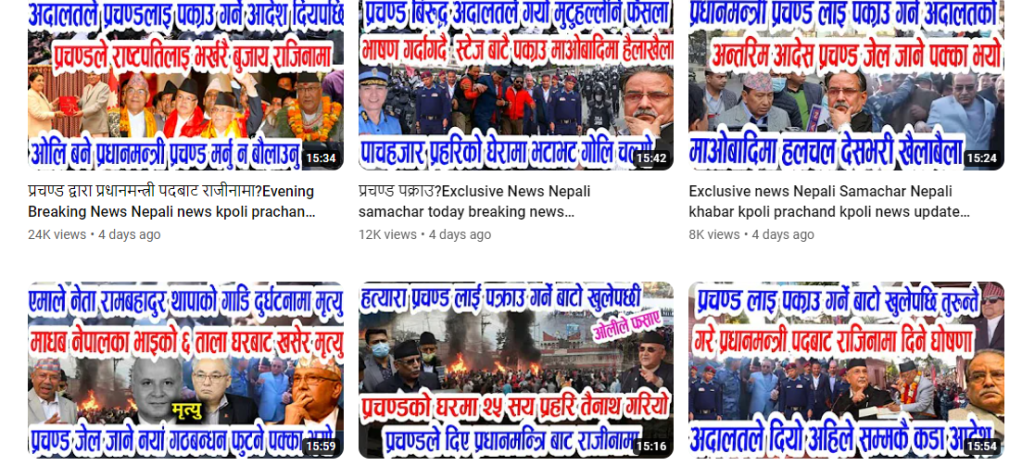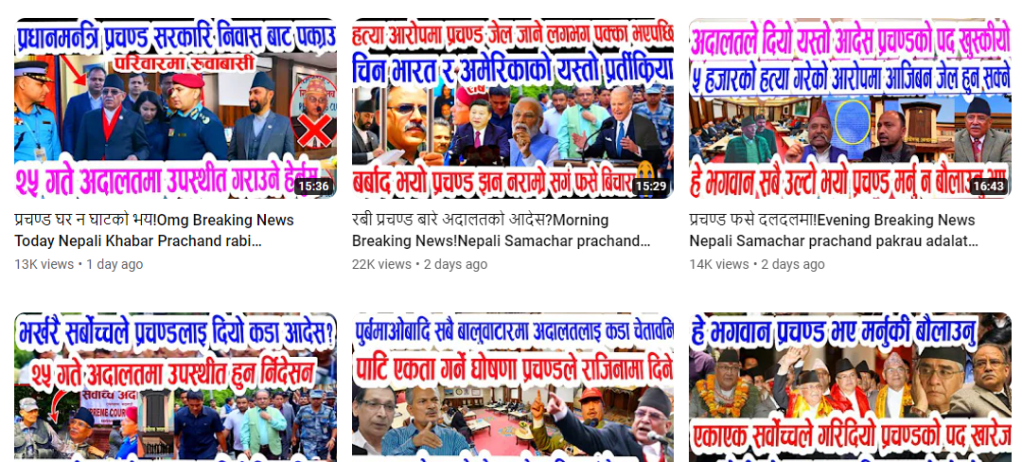
Saraswati Khadka, a 25-year-old Nepali living in Dubai, was recently taken in by a YouTube video claiming that the carcade of the president of Nepal had killed a person.
She believed the information until she discussed it with friends in Nepal and realised that it never happened and no national or local media covered it. It was just an example of the growing problem of misinformation in Nepal.
The video was uploaded to YouTube by Trishuli Khabar TV. It was viewed more than 6,000 times.
Several Nepali language channels on YouTube pose as news media, even though they are not listed by the Press Council Nepal. For instance, Trishuli Khabar TV recently spread fake news claiming that Prime Minister Pushpa Kamal Dahal had to flee his official residence using a helicopter because of mass protests.
YouTube, which has 2.5 billion monthly logged-in users, pays creators for posting videos on the platform, leading to an increasing number of channels claiming to be news media. The platform, bought by Google 17 years ago, claims 500 plus hours of content get uploaded on it every minute.
Last year, fact-checkers from around the world wrote an open letter to YouTube, calling for greater transparency in addressing misinformation on the platform. The letter demanded that YouTube debunk false claims, collaborate with fact-checkers, and take strict action against repeat offenders. The letter also highlighted the need to extend these efforts to languages other than English.
In February 2022, YouTube claimed to have made significant strides in addressing misinformation, outlining the three major challenges they had faced. A year later, Neal Mohan, the company’s new CEO, released a letter indicating the company’s priorities for 2023. However, the letter failed to address the pressing issue of misinformation on the platform.
YouTube has specific community guidelines, including for thumbnails, for content creators. The video-sharing platform says thumbnails or other images that violate community guidelines are restricted. It has also listed the types of restricted thumbnails or photos. The use of pornographic images, nudity, images showing violence, or a thumbnail that misleads viewers is against YouTube’s thumbnail policy. The violation of guidelines may result in receiving a warning or in the termination of the channel or account.
YouTube also does not allow manipulated and misattributed content on the platform. The creators are not permitted to share technically manipulated videos; this includes indications of the death of a government official. It includes the fabrication of events that create a dangerous scenario, such as old footage of military crackdowns or protesters. Violation of misinformation policies results in the removal of the video, a warning to the channel, or a strike.
The guidelines also bar channels from impersonating existing news outlets. With these policies in place, it seems everything is correct and nothing is going wrong on the platform.
“But there is no proper filtering system for Nepali content on the platform, and in this context, only mass reporting is an option for us,” says Rastra Bimochan Timalsena, a YouTuber and lawyer. (Mass reporting is when several people report about the same content).
Nepal Check sent detailed questions to a spokesperson on YouTube. The tech giant refused to answer our questions about the pervasive YouTube-generated misinformation in Nepal. Instead, it issued a statement.
The spokesperson said the company had invested heavily in policies and products aimed at connecting users with authoritative content and removing harmful videos. In the third quarter of 2022 alone, over 121,000 videos were removed globally for violating the company’s misinformation policies, according to YouTube. YouTube and Google in November 2022 announced a $13.2 million grant to the International Fact-Checking Network to establish a Global Fact Check Fund to support their network of fact-checking organisations.
But, apparently, these efforts are not helping efforts to control misinformation in Nepal.
Money behind misinformation in Nepal

Sensational headlines and misleading thumbnails have become commonplace among Nepali language channels on YouTube. Many channels claim to be news media or journalists, yet they are not listed in the Press Council Nepal, giving them a platform to spread false information to their hundreds of thousands of followers.
Trishuli Khabar TV and Nepali Khabar TV are two prominent channels with 619,000 and 163,000 subscribers, respectively, that upload “news” daily. However, they have not registered with the Press Council Nepal, nor have they adhered to the regulations of the 11th amendment to the National Broadcasting Regulation of 1995.
In one example, Trishuli Khabar TV claimed that the Prime Minister of Nepal fled his official residence using a helicopter due to a mass protest that set two cars ablaze, but this event never happened. The video garnered 21,000 views until it was deleted by the owner.
Nepali Khabar TV channel has also been posting videos with misleading thumbnails and false information, such as claiming that a political candidate suddenly pulled out of the presidential race.
While the 11th amendment to the National Broadcasting Regulation of 1995 includes a definition of the internet or online television, these channels have not registered themselves or adhered to the regulations. The lack of accountability has allowed misinformation in Nepal to grow on YouTube.
Who’s behind the channels?
Nepali Khabar TV, a YouTube channel with 163,000 subscribers as of March 1, 2023, published a thumbnail with false information, claiming the CPN-UML party had pulled out of the presidential race.
Despite claiming to “disseminate true and breaking news from home and abroad,” Nepali Khabar TV spreads misinformation in Nepal. The Facebook and TikTok links provided in the channel’s ‘About’ section redirect to personal accounts owned by Janak Nischal Bhusal, who is likely the channel’s owner. While his Facebook profile states that he is based in Kathmandu, he does not claim to be a journalist. Further digging on Facebook reveals that he is also the vice president of the Kuwait Nepali Ekata Samaj, an organisation with ties to the left-leaning Rastriya Janamorcha Party in Nepal.
Bhusal did not respond to queries from Nepal Check.

The YouTube platform’s unique feature of sharing advertising revenue encourages creators to post sensational and clickbait content to attract more views. With 1,000 valid subscribers and 4,000 viewing hours in the last 12 months, a channel can apply for monetisation.
Rastra Bimochan Timalsena, the lawyer, says the revenue earned by a YouTuber depends on the region targeted by the video. However, videos with international views can earn anywhere from Rs 5,000 to Rs 12,000 per month for every 100,000 views.
But misleading content can reach people living abroad who may rely on YouTube as a source of news from their home country. Timalsena says money is the main motive behind such content, but the misuse of the platform may be guided by other motives as well. The effects of misinformation in Nepal can be severe, as once an idea gains widespread acceptance, it can be challenging to prove it wrong or to ensure that fact-checks are heard.
Regulatory response

The Press Council of Nepal has received complaints about YouTube channels spreading misinformation in Nepal and posing as news outlets.
The council monitors social media and YouTube channels and forwards complaints to the Nepal Police’s Cyber Bureau. The council has recommended that the government coordinate with social media companies and establish legal offices in Nepal. Additionally, the council has formed a task force to regulate YouTube and other social media platforms. The council is monitoring 35 YouTube channels that have allegedly violated the code of conduct and will recommend them for prosecution to the Cyber Bureau for violating applicable laws.
Timalsena says the Press Council may not be the appropriate institution to regulate YouTube content since many content creators post videos to spread misinformation in Nepal daily. Nepal requires a stronger mechanism or a new council to regulate content creators on YouTube and maintain a code of conduct on the platform, according to Timalsena.
In Nepal, unlike in India, YouTube “news” is not regulated by the government, as it is not clearly defined under the law. YouTube’s failure to monitor Nepali language content is another barrier, according to critics.
This story first appeared on Nepal Check and Onlinekhabar is republishing it under the Creative Commons licence.



















